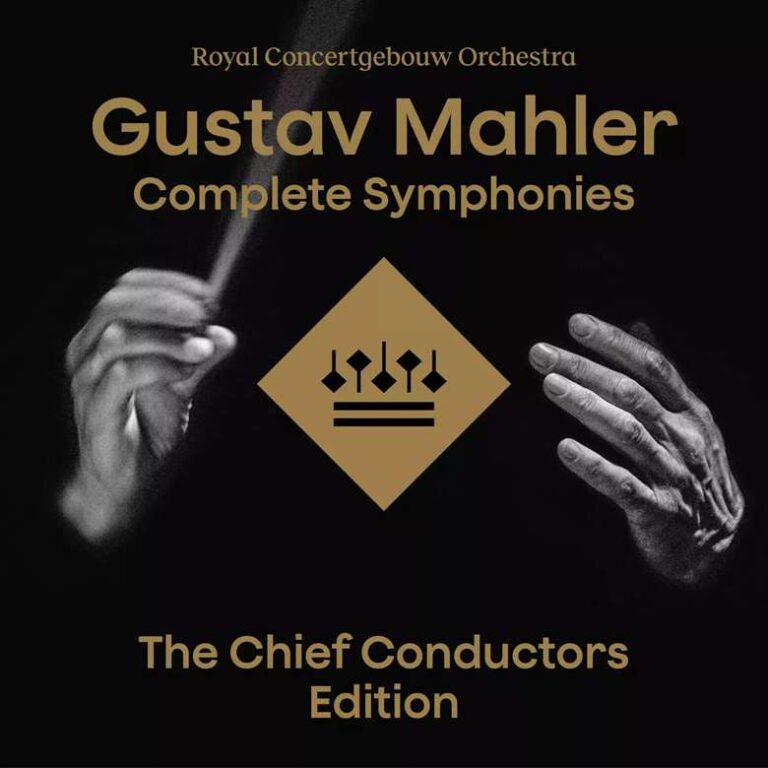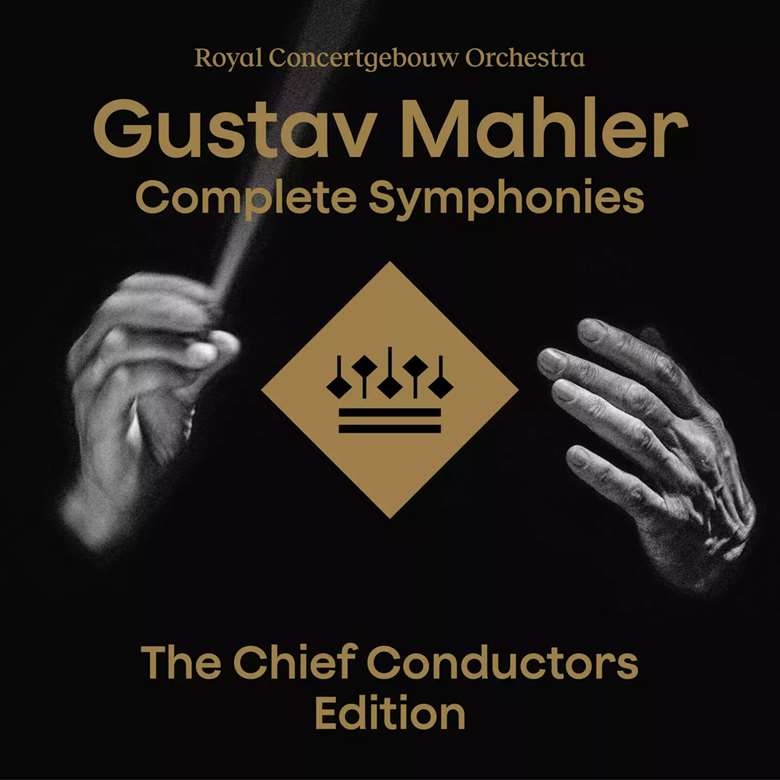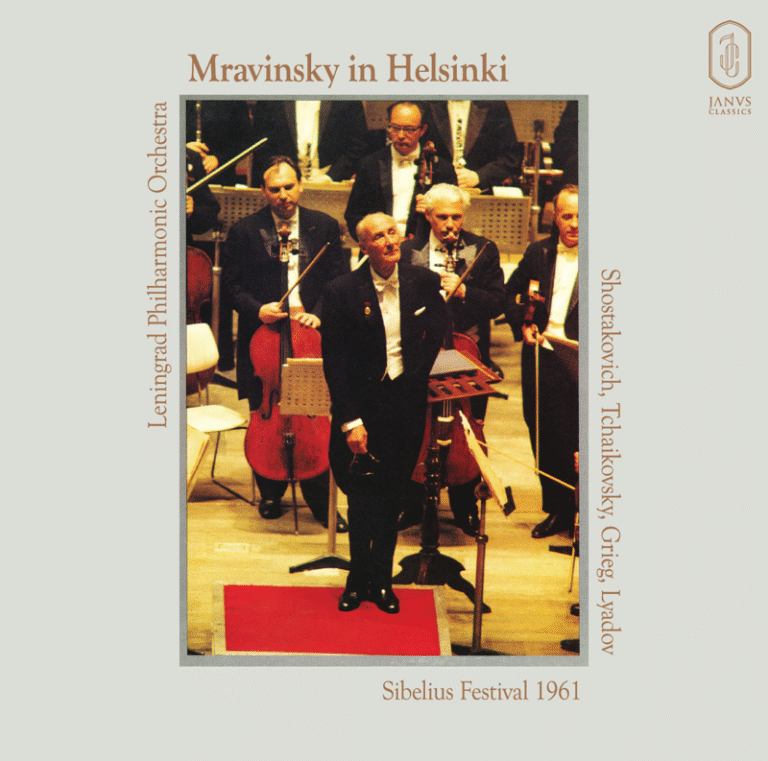
Gustav Mahler – The Chief Conductors Edition
Royal Concertgebouw Orchestra – RCO Live, 2025
Format: 15 CDs, limited edition box set
Label: RCO Live / AVROTROS
Release date: May 2025 (to coincide with Amsterdam Mahler Festival)
Contents:
Complete Symphonies Nos. 1–9
Das Lied von der Erde
Symphony No. 10 (Deryck Cooke performing version)
Performers: Royal Concertgebouw Orchestra
Conductors featured: Willem Mengelberg, Eduard van Beinum, Bernard Haitink, Riccardo Chailly, Mariss Jansons, Daniele Gatti
Recordings: Live radio broadcasts from the Concertgebouw, various years (1939–2016)
Mahler at the Concertgebouw: Great Performances, Weak Presentation: The Missed Promise of the Chief Conductors Edition (2025)
To mark the 2025 Mahler Festival, the Royal Concertgebouw Orchestra has issued a 15-CD box set spanning a century of its chief conductors in Mahler. The ambition is immense, the heritage unquestionable - yet the execution raises questions.
Gustav Mahler’s historic link to Amsterdam and the Royal Concertgebouw Orchestra (RCO) looms large in the marketing of this set. Mahler himself conducted the Concertgebouw Orchestra several times between 1903 and 1911, even exclaiming, « The music culture in this country is astonishing! The way these people can listen! » . Those early encounters have been burnished into legend, forming the basis of the RCO’s vaunted Mahler tradition . Indeed, the notion that no ensemble can claim a more tenacious Mahler lineage has become a proud article of faith in Amsterdam. It is no surprise, then, that this new box set – Gustav Mahler: The Chief Conductors Edition – leans heavily on that legacy. Timed to coincide with the Concertgebouw’s May 2025 Mahler Festival, the limited-edition set assembles live recordings of all of Mahler’s symphonies (plus Das Lied von der Erde and the Cooke completion of the Tenth) as conducted by the orchestra’s successive chief conductors: Willem Mengelberg, Eduard van Beinum, Bernard Haitink, Riccardo Chailly, Mariss Jansons, and Daniele Gatti . On paper, it’s a Mahlerian dream spanning over a century of tradition. In practice, however, this release falls short of its formidable promise in several respects.
Artistic survey: highlights and letdowns
Taken as a whole, the artistic quality of the set is respectable but uneven. The concept of showcasing each chief conductor in "their" Mahler is intriguing, and indeed we hear a broad range of interpretive styles, from Mengelberg’s old-world rubato to Gatti’s modern polish. Yet the results vary widely in merit. A closer look at each entry in this Mahler parade reveals a mix of gems, curiosities, and redundant inclusions:
Symphony No. 1 (Riccardo Chailly, 1999): Chailly launches the cycle with a First that boasts flawless contemporary sonics and the glorious playing you’d expect from the RCO. He has an acute ear for Mahler’s orchestral color, inner details (like harp glissandi and tam-tam strokes) register vividly, and the technical execution is beyond reproach. Interpretively, however, Chailly’s approach comes off as a bit too sleek and controlled. There’s a certain inelasticity in his tempos and phrasing, which keeps much of the performance emotionally lukewarm. Only in the finale does the interpretation catch fire, where Chailly pushes the music to a grandiloquent conclusion, forcefully underlining the march’s almost Verdian melodrama and finally igniting the excitement that the earlier movements somewhat lack.
Symphony No. 2 (Daniele Gatti, 2016): The "Resurrection" under Gatti is a study in contrasts. The opening movement unfolds in broad, lyrical strokes, at times impressively weighty and earthbound (indeed, an "earthy, chthonic" quality permeates the low strings and rumbling basses). Gatti is attentive to Mahler’s markings and draws out some beautifully hushed playing. Yet for all its polish, the performance feels spiritually inert. The finale is massive and imposing, but also heavy-handed and oddly empty: the climaxes turn bombastic, and the music’s transcendence never arrives. At its bloated extremes, Gatti’s Second feels closer in spirit to Klemperer’s granite-faced Seventh Symphony than to a true Resurrection. Even fine contributions from the soloists (mezzo-soprano Karen Cargill delivers a steady, warm "Urlicht") cannot rescue the drawn-out, almost perfunctory final peroration. It’s a grandiose but curiously un-moving account.
Symphony No. 3 (Eduard van Beinum, 1957): This live Third is one of the set’s historical curiosity. Van Beinum, the RCO’s chief in the 1950s, offers a straightforward, somewhat brisk traversal of Mahler’s panoramic score. The recording (a mono radio tape from 1957) has limited fidelity, expect some peak distortion and a constrained dynamic range typical of the era. Still, the remastering (uncredited, unfortunately) has cleaned it up reasonably, and the unique Concertgebouw sonority of the 1950s comes through: the wind playing is pert and characterful, the trombones have a narrow, bright sound, and the trumpets vibrate with old-school color. The first movement, often taken ponderously by modern conductors, here has a refreshing rustic swing, the strings dig into those marching rhythms with gusto. There is less sheer profundity or weight than we might hear today, but the performance charms with its vigor and authenticity. As a historical document, van Beinum’s Third is valuable (especially since he never made a studio Mahler recording), though by present-day standards it isn’t a top contender for everyday listening.
Symphony No. 4 (Willem Mengelberg, 1939): Mengelberg’s legendary Fourth Symphony has long circulated among collectors, but here it appears in a freshly remastered form. This is the earliest performance in the set (recorded in November 1939, just months before the world plunged into war) and it’s a fascinating time capsule of Mahler performance practice as filtered through Mengelberg’s highly personal style. The interpretation is anything but literal – Mengelberg uses extreme tempo fluctuations and elastic rubato, effectively reshaping the music’s narrative on the fly. At times the Viennese lilt and flexibility he brings are thrilling, lending an improvisatory, mercurial character to the journey. The famous sleigh-bell opening is brisk and playful, but later passages breathe and linger unpredictably, often stretching the fabric of Mahler’s score to its limits. Soprano Jo Vincent, Mengelberg’s soloist, sings with a sweet timbre in the finale’s child’s-eye view of heaven; however, her German diction is rather cloudy, and modern ears may find her vibrato-rich style dated. As an interpretation, Mengelberg’s Mahler 4 is controversial, some will find it irresistibly heartfelt and others will deem it mannered and indulgent. Love it or bristle at it, it remains a seminal piece of the RCO’s Mahler heritage. This performance is undoubtedly a flawed gem: not one for everyday listening, but essential for understanding how differently Mahler was heard in the early 20th century.
Symphony No. 5 (Riccardo Chailly, 1997): Chailly’s Fifth is a bit of a puzzling inclusion. It’s a superb performance in many respects: taut, virtuosic playing with a keen structural grip, yet it’s practically identical to Chailly’s well-known studio recording of the Fifth for Decca (which was made at the same time). In fact, this live October 1997 concert occurred during the week Chailly was recording the symphony for commercial release, so the interpretation and even many tempos are the same. The RCO brass blaze brilliantly in the opening funeral march, and the famous Adagietto is smoothly lyrical (if rather swift). There’s absolutely nothing wrong with this account; it’s excellent Mahler by any standard. But it adds nothing new if you’re already acquainted with Chailly’s Decca cycle, it’s essentially a duplicate under slightly different circumstances. As such, this feels like a redundant pick driven by the "chief conductor" concept, rather than something that enriches the set artistically.
Symphony No. 6 (Bernard Haitink, 2001): By the early 2000s, Haitink was an elder statesman of Mahler, and his live Sixth from December 2001 distills both the strengths and weaknesses of his approach. On the positive side, the performance has exceptional clarity and balance. Haitink’s fidelity to the score is unwavering – every detail is in place, the structure is meticulously laid out, and the dreaded acoustic muddiness of the Concertgebouw is minimized by careful control. The tragic sweep of the Sixth comes across in a grim, methodical way. However, what’s missing is a certain ferocity and willingness to take risks. Compared to more visceral accounts (whether the demonic charge of a Szell or the anguished extremes of a Bernstein), Haitink’s reading feels notably restrained. The hammer blows land with precision but not gut-punch impact; the Alma theme sings but doesn’t quite sob. Haitink also adheres to his longstanding view of the score by placing the scherzo second, an order that maintains symmetry but arguably diffuses some of the shock between movements. In sum, this is a dignified, finely crafted Mahler Sixth – one that earns respect, if not wild enthusiasm.
Symphony No. 7 (Mariss Jansons, 2016): Jansons, who led the RCO in the 2000s, is represented with a late-career Seventh (from 2016). This performance showcases Jansons’ strengths in eliciting refined, beautiful playing, but it doesn’t quite grapple with the strange heart of Mahler’s most enigmatic symphony. The execution is unquestionably polished: the Nachtmusik serenades glisten with a Straussian sheen, the orchestral solos (like the tenor horn’s calls) are spot-on, and the complex contrapuntal episodes are handled with transparency. Yet, as a whole, the reading feels oddly inert. The first movement lacks a firm underlying pulse, it comes off episodic and a bit lethargic. The central movements fare better (the shadowy Scherzo has atmosphere), but in the Rondo-Finale, where Mahler’s irony and exuberance should collide in a burst of confusing triumph, Jansons gives us a smooth, almost bland celebration. It’s all very "nice" and musical, but arguably misses the eccentric edge and delirium this work needs. Listeners who desire a safer, more neatly packaged Seventh may appreciate this, but those attuned to the score’s inherent weirdness might be underwhelmed. (Interestingly, Jansons’s earlier Mahler Seventh with the Oslo Philharmonic shows a bit more verve, suggesting that by 2016 his take had mellowed considerably.)
Symphony No. 8 (Mariss Jansons, 2011): Jansons also contributes the massive Eighth Symphony (Symphony of a Thousand), recorded in 2011 with a starry cast and huge choral forces. In many ways this is one of the better executions in the set. The RCO’s famously rich sonority suits the cosmic grandeur of the Eighth, and Jansons’ meticulous preparation yields dividends: the complex Part I (the Veni Creator hymn) is transparent and exciting, with the conductor keeping a tight rein so that the music doesn’t descend into chaos. Part II, Mahler’s setting of the final scene from Faust, unfolds with luminous serenity, the orchestra and chorus achieve genuinely glorious sonorities in the closing pages. The team of vocal soloists is largely excellent, headed by soprano Christine Brewer who soars effortlessly above the stave. If there’s a weak link, it is the principal tenor, whose contribution lacks the heroic heft one might want in Dr. Marianus’s part, a minor flaw in an otherwise strong lineup. Jansons’s interpretive stance in this Eighth is to avoid any overtly personal idiosyncrasies: he smooths over transitions and minimizes grandstanding, aiming for a coherent, radiant sound. The result is a beautifully executed performance that perhaps errs on the side of safety. It may not erase memories of more electrifying Eighths (like Bernstein’s or Tennstedt’s for instance), but it stands as a respectable, at times moving account of this notoriously unwieldy work.
Das Lied von der Erde (Bernard Haitink, 2006): One of the real highlights of the box is Haitink’s Das Lied, taken from a 2006 concert with mezzo-soprano Anna Larsson and tenor Robert Dean Smith. Haitink, then in his late seventies, brings a lifetime of Mahlerian wisdom to this piece. The performance is expansive and glowing, evoking a warm Mediterranean clarity, one might even imagine the golden light on the waters of Lake Bracciano (a poetic metaphor that seems apt for the translucent textures Haitink achieves). Larsson delivers the alto songs with deep, burnished tone and stoic expressivity, while Dean Smith’s lighter tenor rides easily over the orchestra in the drinking song and the jaunty "Von der Jugend". The true test of any Das Lied is the final "Abschied", and here Haitink excels: he unfolds the farewell at a leisurely, 30-minute span, yet it never drags. Time feels suspended as the music gently rises and falls in soft, late-summer breaths. The Concertgebouw players respond with a refinement and color that few orchestras can equal, listen for the plaintive oboe and the delicate tam-tam strokes that shimmer like distant thunder. It’s hard not to be transported by the end, as Haitink lets the closing bars dissolve into silence with utmost delicacy. This Das Lied is, in a word, sublime, easily one of the set’s most indispensable offerings.
Symphony No. 9 (Bernard Haitink, 2011): Haitink’s late Mahler is again on display in the Ninth, taken from 2011, and it provides a fittingly valedictory statement. This is a spacious, unhurried Ninth, all four movements are given ample breathing room. In the first movement, Haitink adopts a flowing, almost detached approach; the music’s seething undercurrents are present, but kept on a tight leash. The "Ländler" second movement lumbers along in deliberately heavy-footed fashion (some might find it too restrained, missing the grotesquerie others bring out). The "Rondo-Burleske" third movement is clean and pointed rather than outright savage. Everything, however, is building to the Adagio finale, and in that final farewell, Haitink and the orchestra truly shine. The long closing pages are achingly beautiful, with the strings producing a radiant, silken tone as the music ebbs away. Haitink doesn’t wring out overt angst; instead, there is a sense of profound acceptance and inner peace. It’s the sound of a great conductor at the end of a long Mahler journey, saying goodbye on his own dignified terms. While this Ninth won’t be to all tastes (those seeking a nightmarish, shattering vision will not find it here), it has a glow and poise that can be deeply moving. In context, it’s also poignant to note that Haitink would soon retire from the Concertgebouw, this performance was effectively his parting gift to the orchestra’s Mahler tradition, and it feels like a gracious farewell blessing.
Symphony No. 10 (Riccardo Chailly, 2000): The set concludes with Chailly’s live Tenth Symphony (performing Deryck Cooke’s edition of the unfinished score) from 2000. This turns out to be one of the more exciting surprises in the collection. Chailly had recorded the Tenth once before (in the 1980s with the Berlin Radio Symphony), but this later performance with the Concertgebouw is on a different level. The conductor seems far more at home with Mahler’s fragmented, otherworldly swansong here. The opening Adagio is deeply felt and wonderfully paced, building to a wrenching brass-climax and a haunting, distant disintegration. In the central movements, Chailly brings out biting character, the evil grin of the second movement Scherzo, the bizarre, clattering sarcasm of the brief Purgatorio third movement, and the woozy Ländler of the fourth all come through vividly. Notably, Chailly makes an interpretive tweak in the finale: just before the last movement’s funeral march begins, he has the drummer play a series of extra grace-note ruff figures leading into the main drum stroke motif. This added touch (not in the published score, but arguably hinted by Mahler’s sketches) creates an arresting military tattoo effect, ratcheting up the tension before the final Adagio’s anguished cry. It’s a fascinating detail that shows Chailly’s willingness to be imaginative. The finale itself is very well-shaped, with the RCO brass and strings pouring out a rich, Mahlerian soundscape of grief and release. By the end, one feels that something important has been achieved – the performance communicates urgency and conviction. Alongside Haitink’s Das Lied, Chailly’s Tenth stands as one of the few truly essential items in this box set.
editorial failings: a prestige project undercut by poor presentation
With an institution as prestigious as the Concertgebouw and a project tied to a major festival, one would expect top-notch editorial presentation. Unfortunately, this set’s producers have delivered a scandalously poor booklet and packaging. There are no detailed recording notes or technical information about the sources and remastering, a baffling omission given that many of these performances are historic broadcasts being released on CD for the first time . For example, the Third and Fourth Symphonies are advertised as newly remastered , yet the booklet fails to even mention who undertook these remasterings or what was done. Contextual notes about why these particular recordings were chosen (over alternate performances in the archive) are likewise absent; instead, we get only a generic celebratory essay. For a project of this scope, such a meager effort is inexcusable.
Equally egregious is the lack of texts or translations for Mahler’s vocal works. The set includes Das Lied von der Erde and the choral Eighth Symphony, yet provides no song texts, poetry, or translations for the listener. Seasoned Mahlerians may not need a libretto, but omitting these basics in a luxury edition shows a surprising indifference to scholarly and listener needs. It’s a stark contrast with the self-congratulatory rhetoric in the label’s promotional materials, which trumpet the orchestra’s history and the "unique" nature of this edition . In essence, the marketing promises a landmark release, but the execution feels more like a cut-price product. Even the physical design of the box is underwhelming, a flimsy package that, according to some reports, tends to spill its contents if handled carelessly (a minor annoyance, but symbolic of the overall carelessness). All told, the editorial and presentation aspect of this set is disappointing to the point of being scandalous for such a high-profile endeavor.
In the end, this Mahler box set proves to be a missed opportunity. The Royal Concertgebouw Orchestra is justly celebrated as one of the world’s greatest Mahler ensembles, which is precisely why we were entitled to expect the very best from a release like this. With the occasion of the 2025 Mahler Festival and all the fanfare invoking Mahler’s own history with the RCO, this could have been a definitive collection to crown the orchestra’s tradition. Instead, we have an edition that delivers intermittent greatness but falls short of consistent excellence, and which is hampered by regrettably poor editorial choices.
To be sure, there is much to admire across these 15 CDs: moments of sheer interpretive insight, superb orchestral playing, and a palpable sense of the Concertgebouw’s unique Mahler heritage. Die-hard Mahlerians and RCO devotees will find enough here to savor, and for them the set might well be indispensable as a document of a storied legacy. However, the general listener or collector in search of the ultimate Mahler cycle might be better served elsewhere, by more unified cycles or individual recordings that capture these works at their best. The Chief Conductors Edition stands as a grand souvenir, a compilation that memorializes the past more than it illuminates the present.
In summary, Gustav Mahler - The Chief Conductors Edition offers an illuminating but uneven journey through Amsterdam’s Mahler tradition. It reminds us of the RCO’s long love affair with Mahler’s music, even as it exposes the pitfalls of trying to curate that history into a "complete" box set. Our final verdict:
Artistic value: ★★★½☆ (3.5/5)
Editorial value: ★★☆☆☆ (2/5)



